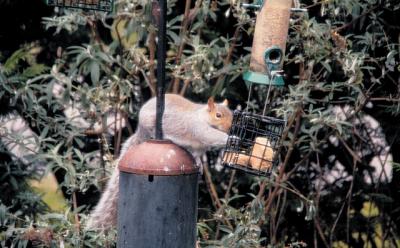Nature Notes: Squirreled Away

As many of you readers have observed (or heard falling in the night), there was a tremendous crop of acorns this year, notwithstanding the dryish summer. More acorns should produce more squirrels, which are famous feeders on acorns during the winter months, having squirreled hundreds away during the fall.
One indication of the size of the gray squirrel population is the number of them killed on the roads in a given year. This past year was a big year for squirrel roadkills here. I’ve recorded on average one per day.
Another indication of squirrel numbers is the number of nests, or dreys, along a given stretch of road or throughout a neighborhood. Squirrels remain active throughout the winter unlike two other local rodents, groundhogs and chipmunks, which hibernate. They prefer holes in trees or attics, but when they run out of these two options, the next best option is a drey perched up in a tree, almost invariably a hardwood tree.
Last winter I noticed an uptick in the number of dreys on the South Fork compared to previous years. This year there is a bumper crop of them. They are very easy to observe after the leaves fall, say from mid-November on. A drey is little more than a bunch of dried leaves loosely woven together to form a round hollow nest about the size of a basketball placed in the crotch of a tree generally 40 or more feet above the ground. Some of them are reinforced with twigs and small branches.
Squirrels are adept at using their forepaws and so can cobble one of the leaf nests together in a matter of hours. They usually make the nest when there is no one or no predators around to observe them. They are a favorite of red-tailed hawks, so they keep out of sight as much as possible when they are high in the trees.
On Monday afternoon I drove around the main arteries and back roads in Sag Harbor, East Hampton’s Northwest Woods, and the hamlet of Wainscott looking through the windshield counting dreys. Because the trees were bereft of leaves I was able to see about 100 feet on each side of the road. During the observation period of about 90 minutes I counted the dreys along 34 miles of road.
They were most numerous in residential areas in oak hardwood forests with with very few pines or in treed shoulders bordering fields. The greatest density was found on a stretch of Stephen Hand’s Path in East Hampton between Bull Path and Route 114, where there were 12.3 dreys per mile. They were also abundant along the sides of Wainscott Harbor Road and Merchants Path, where they averaged eight per mile. All told I counted 102 dreys over a course of 34 miles. There were almost no dreys in the areas of Northwest where the pines outnumbered the oaks. The lowest number of dreys per mile was Daniel’s Hole Road between Montauk Highway and Route 114, a distance of a little more than three miles. I counted two as the road approached 114 on the north, for an average of .6 per mile. Daniel’s Hole Road is very close to or runs through the East Hampton Airport and one wonders if the squirrels are bothered by the noise of the jets and helicopters as much as the people are.
North Haven, which has very few coniferous trees, had a relatively high number of dreys. The stretch between the traffic circle north to the ferry terminal, a distance of about two miles, had 13 dreys for an average of 6.25 per mile.
Dreys can host more than one squirrel at a time. In many cases a cluster of three or four dreys would be found within a circle less than 200 feet in diameter. One wonders if the 2015 offspring, now almost full-grown, fashion dreys close to those of their parents. When a mother is raising young and using a drey as a part-time home, she is usually the sole adult inhabitant.
Almost all of the nests were 40 to 65 feet high, as few as five were 20 to 40 feet high. Lower dreys were found in woods where the trees were shorter, for example, Hand’s Creek Road in East Hampton and upper Stephen Hand’s Path. The denser the human habitation, the more dreys per mile. Old Northwest Road and Bull Path in Northwest are sparsely populated and had only two and four dreys, respectively. They also can be piney.
Squirrels, like deer, turkeys, and chipmunks, and white-footed mice, are as common in residential areas as they are in the outlying ones. Dense residential areas have far more bird feeders than less populated areas and squirrels are not one to turn down free handouts. Despite all of the modern squirrel-inhibiting bird feeder contraptions on the market, most of them have an Achilles’ heal when it comes to squirrels. They are not dummies.
It remains to be seen if there will be as many dreys next fall as this one. Oaks vary their yields from year to year; more than half the time they produce a small crop. When acorns are scarce as they were in, say, the winter of 1994-95, the number of squirrel roadkills shot up astronomically, as squirrels were forced to wander from their home territories to find food, often crossing busy roads to do so.
Larry Penny can be reached via email at [email protected].
